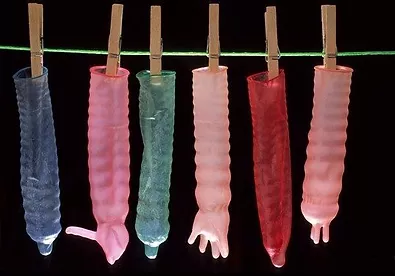Condom 101
There are levels to this
WHAT ARE THE DIFFERENT TYPES OF CONDOMS?

There are many, many types of condoms. Here’s what you should know about the most common types:
Latex: Most condoms are latex. If you use lube with them, always choose one that’s water-based or silicone. Oil-based lubes will degrade the condom and cause it to break.
Non-latex: These condoms are a great option if you’re allergic to latex. Just know that the lambskin variety of non-latex condoms block sperm, but won’t protect against STDs.
Internal condom (aka the FC2 or “female condom”): This non-latex condom can be inserted vaginally or anally. It’s a great option for people who have trouble with a traditional external condom or for people with latex allergies.
You can get a couple of these types when you use our condom order form!
WHICH STDs CAN BE PREVENTED BY USING A CONDOM?
A whole bunch! Condoms will protect you from gonorrhea, chlamydia, trichomoniasis, HIV, and any other STDs that are passed through genital fluids. Unfortunately, most traditional condoms won’t prevent skin-to-skin infections like herpes or HPV. However, the FC2 can offer some protection there, because its unique design actually covers up some of the vulva or the outer part of the anus, depending on where you’re using it.
HOW CAN I USE A TRADITIONAL CONDOM CORRECTLY?
Remember that condom on a banana demonstration in sex ed class? Turns out, it’s actually a pretty good guide for how to roll a condom on. But in addition to your rolling technique, there are a few things you can do to to use a traditional condom correctly.
First things first: Buy the right condom. Believe it or not, this is not a one-size-fits-all situation. This website is a great guide for figuring out your condom size.
And we know you want to be prepared, but it’s not a great idea to store condoms in a wallet, back pocket, or loose in a purse. That’s because they’re easily punctured in those locations — and a punctured condom doesn’t do you much good. Instead, store your condoms in a cool, dry place, like a bedside table, cabinet, or even under your bed. And if you want to have one on the go, condom tins are a great option. You can find them online or in your local sex positive sex shop.
Condoms with holes are no good — and so are expired ones. Just like the food in your fridge, your condoms can go bad. So check the expiration dates on your condoms every once in a while and throw out any that are past their prime.
Lube it up! But, remember: Only silicone or water-based. Oil degrades latex and could cause your condom to break or even put tiny little holes that sperm and STDs can swim through, even though you can’t see them.
When you’re actually in the moment, be careful when you’re opening the condom. We know you’re in a rush to keep things moving, but you don’t want to tear the condom — that’ll slow things down even more. Also, make sure the penis is all the way hard before before putting the condom on. Otherwise, it could slip off again.
Sex can involve a lot of different acts. If you’re switching between vaginal and anal intercourse — or you just need a little break before you get going again — make sure to use a new condom. That protects you and your partner against any cross-contamination of fluids or bacteria.
And last — but certainly not least — when you’re finished, be sure to take the condom off properly. Hold the base, slide it down, and tie it off for proper disposal. This article includes illustrations on the right way to take off a condom.
For more information and assistance, the Delaware County Health Department Wellness Line is available 24 hours a day, 7 days a week. In addition to responding to phone calls, the Wellness Line also responds to email inquiries.
Phone: (484) 276-2100 (Available 24/7)
Email: DelcoWellness@co.delaware.pa.us
